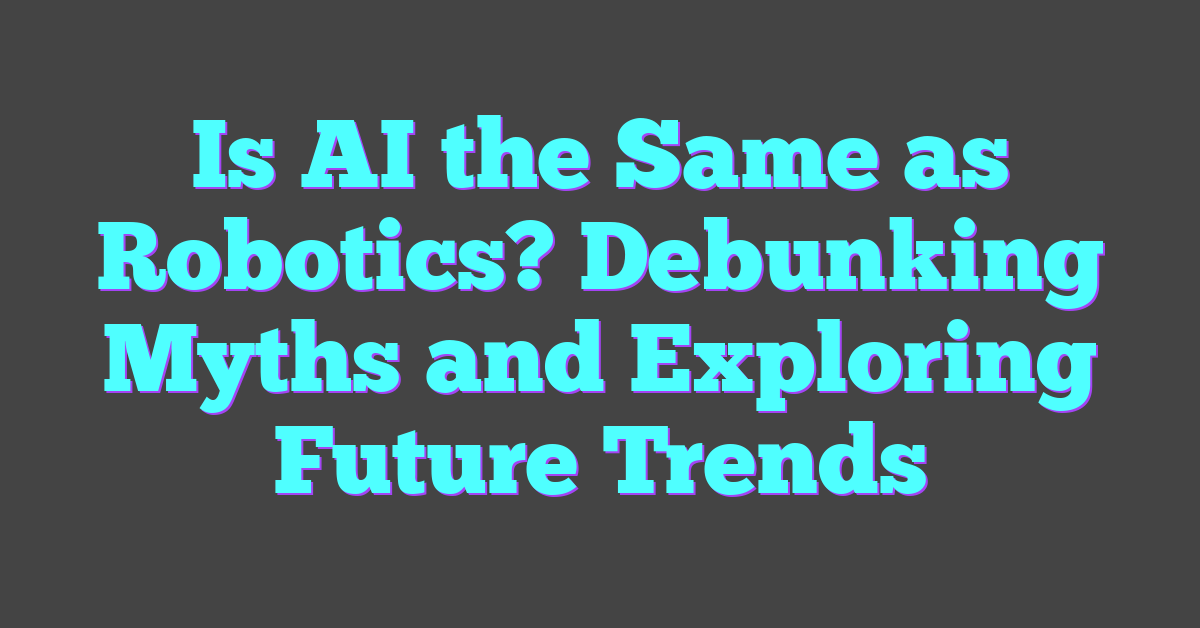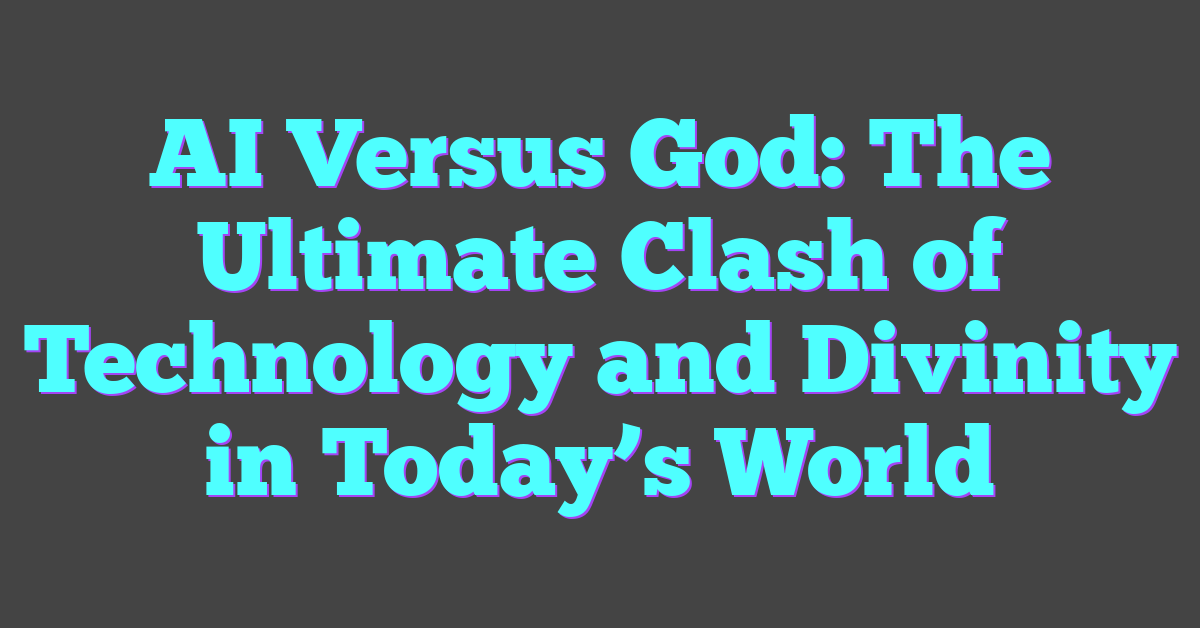Many people often use the terms AI and robotics interchangeably, but they’re not quite the same thing. While both fields share a common goal of creating intelligent systems, their approaches and applications differ significantly. AI focuses on developing algorithms that can mimic human intelligence, enabling machines to learn, reason, and make decisions.
On the other hand, robotics deals with designing and building physical machines that can perform tasks autonomously or semi-autonomously. These robots may or may not use AI to operate. Understanding the distinction between AI and robotics is crucial as it helps in appreciating how these technologies can complement each other to revolutionize various industries.
Understanding AI and Robotics
Knowing the distinctions between AI and robotics is essential for grasping their unique roles and collaborative potential in tech innovations.

Definitions of AI and Robotics
Artificial Intelligence (AI): AI refers to systems and algorithms that simulate human intelligence, enabling machines to perform tasks such as learning, problem-solving, and decision-making. AI encompasses various subfields, including machine learning, natural language processing, and computer vision.
Robotics: Robotics involves designing, building, and programming physical robots to carry out tasks autonomously or semi-autonomously. Robotics integrates engineering and computer science to create machines capable of executing complex actions in real-world environments. Examples include industrial robots, medical robots, and consumer robots like vacuum cleaners.
Key Differences Explained
Fundamental Focus: AI centers on developing cognitive functions in software, while robotics focuses on the physical construction and operation of robots.
Applications: AI applications include virtual assistants (e.g., Siri), recommendation systems, and autonomous decision-making platforms. Robotics applications span manufacturing automation, surgical procedures, and exploration missions.
Integration: Although distinct, AI and robotics often intersect. AI technologies enhance robotic systems, enabling them to process complex data and make informed decisions. For instance, an autonomous drone uses AI for navigation and obstacle avoidance but relies on robotics for its physical movement and stability.
Understanding these definitions and differences clarifies how AI and robotics serve different but complementary roles in advancing technology.
The Intersection of AI and Robotics
AI and robotics intersect significantly, with AI enhancing the capabilities of robots and expanding their application areas.
How AI Enhances Robotics
AI improves robotics by enabling robots to process data, learn from experiences, and make decisions autonomously. Integration with machine learning algorithms allows robots to adapt to new tasks and environments. For instance, computer vision helps robots recognize and interact with objects, while natural language processing allows them to understand and respond to human commands.
- Self-Driving Cars: AI algorithms process sensor data to navigate and drive autonomously.
- Healthcare Robots: Robots assist in surgeries, leveraging AI for precision.
- Manufacturing: AI-powered robots streamline production lines by performing complex tasks efficiently.
- Service Robots: AI aids robots in customer service, handling inquiries and providing assistance.
These intersections between AI and robotics highlight their complementary relationship, driving innovation across various fields.
Misconceptions About AI and Robotics
Many confuse artificial intelligence (AI) with robotics, though they are distinct fields. AI focuses on simulating human intelligence, while robotics specializes in creating autonomous machines.
Debunking Common Myths
Several myths persist about AI and robotics despite their differences.
AI Equals Robotics: Some believe AI and robotics are the same. AI provides the “brain” that enables robots to interpret data and make decisions, but not all AI systems are linked to physical robots.
Robots Will Replace All Jobs: While robots integrated with AI can automate certain tasks (like in manufacturing or logistics), they supplement human roles, enhancing efficiency rather than replacing the workforce entirely.
Robots with AI Will Become Sentient: Films often depict AI-powered robots gaining consciousness. In reality, AI algorithms don’t possess self-awareness or emotions; they excel at pattern recognition and problem-solving within defined parameters.
All Robots Use AI: Not all robots utilize AI, and many operate via pre-set instructions or basic automated systems. AI-driven robots represent an intersection of robotics and advanced machine learning.
AI in Robots Eliminates Human Error: Integrating AI into robots reduces some errors, but not all malfunctions or inaccuracies. Ongoing human oversight remains critical, especially in complex environments like healthcare and autonomous driving.
Understanding these myths clarifies the roles and limitations of AI and robotics. Dispelling these misconceptions fosters a more informed discussion about their collaborative potential and societal impact.
The Future of AI and Robotics
The future of AI and robotics offers exciting prospects, merging advanced technology with various aspects of society. Understanding emerging trends and innovations in this field helps to appreciate their potential.
Emerging Trends and Innovations
Advancements in AI and robotics continue to evolve rapidly. Researchers focus on new techniques like deep learning and neural networks, which improve the ability of AI to process information and make decisions. For example, AI algorithms now outperform human accuracy in image and speech recognition tasks.
Robotics innovation includes the development of soft robotics, which mimics biological entities. Soft robots offer increased flexibility and safety, allowing for new applications in medical and caregiving fields. Additionally, collaborative robots (cobots) work alongside humans in industrial settings, improving efficiency and safety.
Another trend is the integration of AI and the Internet of Things (IoT). AI enhances IoT devices by providing real-time data analysis, leading to smarter environments. For instance, smart homes use AI for energy management and security, optimizing daily operations.
The future also holds significant potential for AI and robotics in autonomous vehicles. Self-driving cars utilize AI for navigation and decision-making, reducing human error and increasing road safety.
Emerging AI-powered robots in agriculture promise to revolutionize farming. They can identify crops needing care and optimize harvesting processes. Moreover, advances in AI enable drones to perform aerial surveys, providing farmers with crucial data for crop management.
These trends and innovations illustrate the dynamic and intertwined nature of AI and robotics, showcasing their transformative potential in various industries.
Conclusion
AI and robotics, while distinct, complement each other in remarkable ways. As technology evolves, their integration opens up endless possibilities for innovation and efficiency. By understanding their differences and potential, society can better prepare for a future where AI and robotics play a crucial role in various industries. Embracing these advancements can lead to smarter, more efficient environments that benefit everyone.
Frequently Asked Questions
What is the main difference between AI and robotics?
AI focuses on mimicking human intelligence for tasks such as learning and problem-solving, while robotics is about creating autonomous machines. They often work together but are distinct fields.
Can AI and robotics work together?
Yes, AI can enhance robotics by providing intelligent decision-making capabilities, allowing robots to perform complex tasks more efficiently and adaptively.
Are AI and robots the same thing?
No, AI is a technology for simulating human intelligence, whereas robots are physical machines designed to perform specific tasks, with or without AI.
Will robots replace all human jobs?
No, while robots can automate certain tasks, they are more likely to augment human abilities and take over repetitive jobs, leading to new job opportunities in other sectors.
Can robots with AI become sentient?
Current technology does not allow robots to become sentient, meaning they cannot achieve self-awareness or consciousness. This remains a speculative topic.
Do all robots use AI?
Not all robots use AI. Some are programmed for specific tasks without requiring AI for decision-making or adaptability.
Does AI in robots eliminate human error completely?
AI can reduce human error in many situations, but it does not eliminate it entirely. AI systems and robots can still fail or make mistakes based on faulty data or programming errors.
What are some emerging trends in AI and robotics?
Emerging trends include deep learning, neural networks, soft robotics, collaborative robots, and the integration of AI with the Internet of Things (IoT), enhancing capabilities and creating smarter environments.
How will AI and robotics impact future industries?
AI and robotics are transforming various industries such as autonomous vehicles, agriculture, healthcare, and manufacturing, improving efficiency, precision, and overall productivity.




